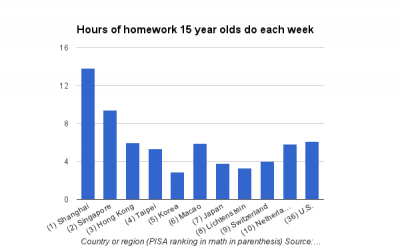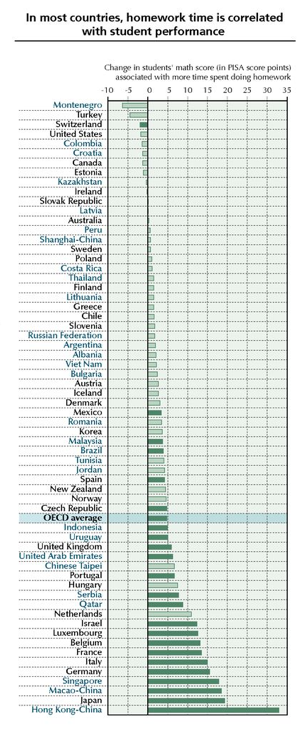For years, researchers have been trying to figure out just how important homework is to student achievement. Back in 2009, the Organization for Economic Cooperation and Development (OECD) looked at homework hours around the world and found that there wasn’t much of a connection between how much homework students of a particular country do and how well their students score on tests. Some top achieving countries, like Singapore, assign their students lots of homework. But Finland, for example, succeeds without much homework. On average, Finnish students do only about three hours of homework a week, yet in 2012 they scored sixth highest in the world in reading and 12th highest in math on the OECD’s international test, known as PISA or Programme for International Student Assessment.

This article also appeared here.
But now, five years after the earlier homework study, OECD researchers have drilled down deeper into homework patterns, and they’re finding that homework does play an important role in student achievement within each country. Specifically, they found that homework hours vary by socioeconomic status. Higher income 15-year-olds tend to do more homework than lower income 15-year-olds in almost all of the 38 countries studied by the OECD*. Furthermore, the kids who are doing more homework also tend to get higher test scores. So the authors conclude that homework is reinforcing the achievement gap between the rich and the poor.
It’s not just that poor kids are more likely to skip their homework, or don’t have a quiet place at home to complete it. It’s also the case that schools serving poor kids often don’t assign as much homework as schools for the rich, especially private schools, explained Francesca Borgonovi, one of the authors of the study, titled “Does Homework Perpetuate Inequities in Education?”
“When you look within countries at students who are learning in the same educational system and they do more homework, then those students do much better,” said Borgonovi. “There is an advantage for putting extra hours in homework.”
A stark example of this rich-poor homework gap is in Singapore. Students in the top quarter of the socio-economic spectrum spend about 11 hours on homework a week, 3 hours more than low-income students in the bottom quarter of the socio-economic spectrum. Each extra hour of homework was associated with 18 more points on the PISA math exam. So three hours adds up to more than 50 points. That’s huge. To put that in perspective, if you added 50 points to the average U.S. math score, we’d be a top 10 nation instead of number 36.
A key factor is what Borgonovi said about “learning in the same educational system.” Some school systems are designed to rely on homework, perhaps using independent study as a substitute for what could otherwise be learned in school. “If you are prepared to change the system, that’s great,” said Borgonovi. “But until you do so, if the system is based on homework, then you should do more of it.”
Students in Shanghai, a region in China that now leads the world in PISA test scores, do a whopping 14 hours of homework a week, on average. Wealthier students there do 16 hours. Poorer students do just under 11 hours. Interestingly, however, there was no association between the extra homework hours that the wealthier Shanghai kids put in and their PISA test scores. Perhaps that’s because there are diminishing marginal returns to homework after 11 hours of it!
Indeed, most countries around the world have been reducing the amount of homework assigned. Back in 2003, the average time spent on homework worldwide was about six hours a week. In 2012 that shrank to about five hours.
But the United States has been bucking this trend. The typical 15-year-old here does six hours a week, virtually unchanged from a decade ago and possibly rising. Wealthier students typically do eight hours of homework a week, about three hours more than low income students. But unlike in most countries, where more homework is associated with higher PISA test scores, that’s not the case here.
“For the United States, we don’t have homework reinforcing inequality,” Borgonovi said.
Another team of researchers, Ozkan Eren and Daniel J. Henderson, found mixed results for how effective homework is in the United States, in a 2011 study, “Are we wasting our children’s time by giving them more homework?” published in the Economics of Education Review. For math, there were huge benefits for the 25,000 eighth graders they studied. But not for English, science or history. And the math boost was much stronger for white students than for blacks. In other words, when a typical black student did more homework, his math test scores didn’t go up as much.
That’s perhaps a clue that even if you could magically get low-income children in other countries to do as much homework as their high-income peers, as the OECD researchers are suggesting, you might not raise their PISA test scores very much.
Indeed, Borgonovi isn’t really advocating for more homework. She says that high quality teachers and instruction are much more important to student outcomes than homework is. To be sure, some amount of homework is good, Borgonovi said, to teach kids how to plan ahead, set goals and work independently. But more than four hours of homework a week, she said, isn’t very beneficial.
“It would be better to redesign the system to have less homework,” said Borgonovi. “But that is hard to do.”
* The OECD looked at socio-economic status and not income exclusively. So the child of a university professor, for example, might still be in the high income category even if his parents don’t make very much money.





